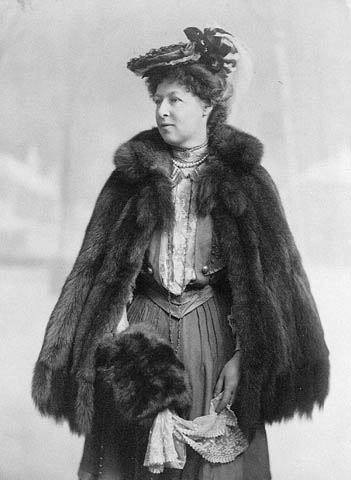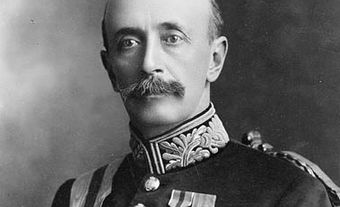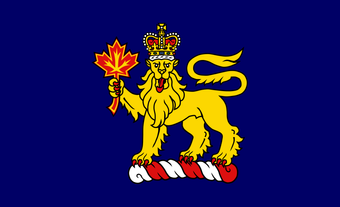
(courtesy Patent and Copyright Office / Library and Archives Canada / C-019280)
Early Life and Family
Lady Grey was born Alice Holford, the youngest of four children of Robert Stayner Holford and Mary Anne Lindsay. Her father was a prominent landowner, a Conservative member of Parliament for East Gloucestershire from 1854 to 1872 and a prolific collector of fine art and botanical specimens. Her mother was the granddaughter of Sir Coutts Trotter, the principal partner in Coutts bank, who also belonged to a family of art collectors. Her uncle and aunt, Sir Coutts and Lady Blanche Lindsay, founded Grosvenor Gallery in London.
Alice’s parents commissioned the rebuilding of Westonbirt House, described by Country Life Magazine as “the finest example of Victorian architecture, landscape and gardens in the Cotswolds.” The Holford family had a strong interest in landscape gardening, and Alice’s father and brother established what became the National Arboretum at Westonbirt.

(photo by Alfred G. Pittaway, courtesy Library and Archives Canada / C-001017)
Marriage and Children
The Holford family made frequent visits to Italy to acquire art. On one of those trips, Alice met Albert Grey, the future 4th Earl Grey. According to Grey’s biographer, Harold Begbie, “She was almost a child when he fell in love with her at their first meeting in Florence. She was only eighteen when they married.” The wedding took place on 9 June 1877. Alice accompanied her husband to Southern Rhodesia (now Zimbabwe) during his term as administrator during the Second Matabele War.
Earl and Lady Grey had five children: Lady Victoria (1878–1907); Lord Charles, 5th Earl Grey (1879–1963); Lady Sybil (1882–1966), a photographer and filmmaker who was invested as an Officer of the Order of the British Empire for her work as a hospital administrator during the First World War; Lady Evelyn (1886–1971); and Lady Lillian (1891–1895).

(photo by Galbraith Photo Company, courtesy Library and Archives Canada / C-050179)
Viceregal Consort of Canada
Lady Grey accompanied Earl Grey to Canada in 1904 when he succeeded his brother-in-law, Lord Minto, as governor general. Lady Grey was the first viceregal consort to be styled officially as “Your Excellency,” a practice that continues to the present day.
The couple’s two youngest surviving daughters, Sybil and Evelyn, accompanied their parents to Canada and served as their mother’s ladies-in-waiting. Forty years after her father’s term as governor general, Sybil remarked, “If I were a young man now, I think I would emigrate to Canada that land of sunshine and illimitable possibilities, where if you are prepared to work hard and turn your hand to anything, you can hardly fail to succeed.”
In 1910, British journalist Sarah Tooley described Lady Grey’s annual routine as viceregal consort as follows:
The life of the governor-general’s wife has three main divisions – the winter and parliamentary season at Government House, Ottawa; spring and summer sojourns at the Citadel, Quebec; and a period devoted to exploring the interesting parts of the colony, and accompanying his Excellency on his tours to the distant parts of the Dominion. Visits are also paid to Montreal, Toronto, and the other chief cities in the provinces, where she meets the lieutenant-governors and their wives, and takes part in social functions.
Key events on the social calendar included Christmas dances, the New Year’s reception, the opening of Parliament, the Easter Ball and summer garden parties.

(courtesy Geological Survey of Canada / Library and Archives Canada / PA-045286)
According to Tooley, Lady Grey was expected to adapt to Canadian winters and continue her busy schedule of public appearances, regardless of the temperature. “With the first fall of snow, her Excellency and family don the fur-lined garments, sealskin headgear, fur gloves, and moccasins with which to face the rigours of the Canadian winter. ‘Our Lady of the Snows’ [a reference to an 1897 Rudyard Kipling poem] is a little sensitive on the matter of climate, so her Excellency must not appear to be in terror of the frost-bite.” Earl and Lady Grey held regular Saturday afternoon skating and tobogganing parties throughout the winters.
Did You Know?
English writer Rudyard Kipling wrote the poem “Our Lady of the Snows” in reference to the British Preferential Tariff enacted by Canada in 1897. This tariff gave preference to goods from the United Kingdom and other British Dominions.
A Nation spoke to a Nation,
A Queen sent word to a Throne:
“Daughter am I in my mother’s house,
But mistress in my own.
The gates are mine to open,
As the gates are mine to close,
And I set my house in order,”
Said our Lady of the Snows.
Kipling visited British Columbia on several occasions and, at one point, owned land in Vancouver.
Lady Grey shared her family’s interest in landscape gardening and art. She made improvements to the Rideau Hall grounds, planting daffodils on the west lawn that are still present today. A visitor to Rideau Hall observed the acquisition of new portraits of royalty and past governors general (which remain at Rideau Hall today) and that “the conservatories are very fine and are the especial care of Her Excellency the Countess Grey.” Following the example of her sister-in-law and predecessor, Lady Minto, Lady Grey presented awards for the best-kept gardens in Ottawa.
Charitable Activities in Canada
Lady Grey supported numerous philanthropic organizations in Canada, focusing on emigration to Canada, women’s health, landscape gardening and antiquities; these reflected her own interests and those of her family. She was president of the Lady Aberdeen Association for Distribution of Literature to Settlers in the West, which provided books and magazines to prairie households. She was also patroness of the Women’s Welcome Hostel in Toronto, which provided accommodation for single women who emigrated to Canada to seek employment in domestic service. Lady Grey was honourary president of the Ottawa Maternity Hospital, the Victorian Order of Nurses and the Women’s Branch of the Numismatic and Antiquarian Society of Montreal. She organized the efforts of Ottawa women to raise money for the victims of the Great Fire of 1908 that burned down the community of Fernie, British Columbia. She turned the first sod for the monument to the War of 1812 Battle of Stoney Creek, which was sponsored by the Wentworth Historical Society.
Lady Grey was an active fundraiser for her patronages and received substantial donations, including $1,000 from Prince Fushimi Hiroyasu of Japan, who toured Canada in 1907. She was well regarded in Canada for her “kindly, gracious manner,” which “endeared her to all classes in the Dominion.”
Later Life
Lady Grey continued to support nursing and hospitals during the First World War. She encouraged her daughter, Lady Sybil, to establish the Anglo-Russian hospital in Saint Petersburg, a gift from the British dominions to their First World War ally, the Russian Empire. The hospital remained active until the Russian Revolution of 1917. Lady Grey was widowed in 1917 and remained active in philanthropy and landscape gardening to the end of her life.

 Share on Facebook
Share on Facebook Share on X
Share on X Share by Email
Share by Email Share on Google Classroom
Share on Google Classroom

